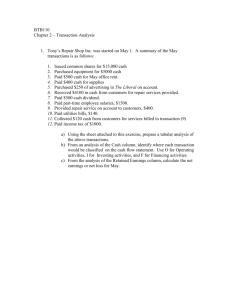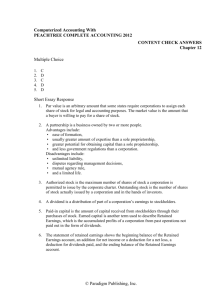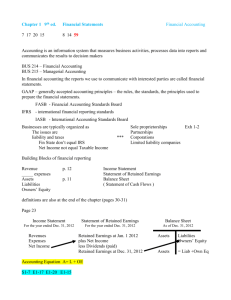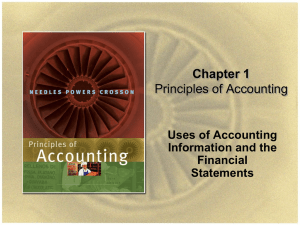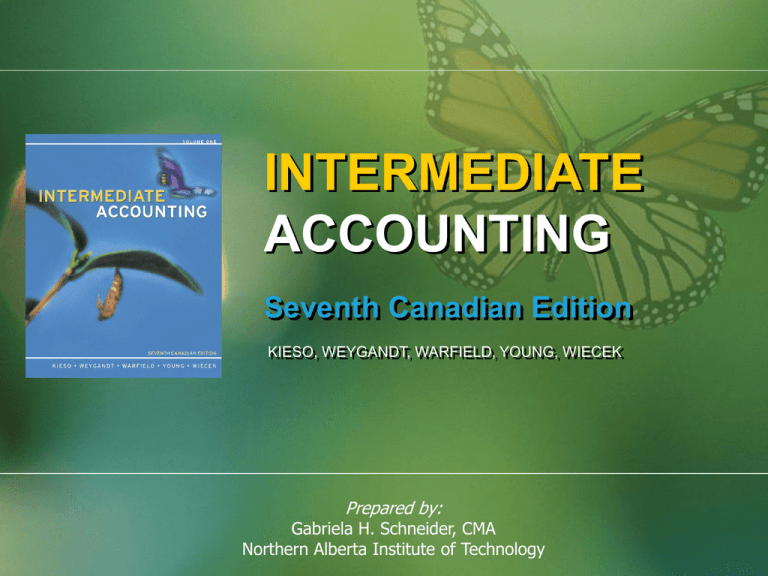
INTERMEDIATE
ACCOUNTING
Seventh Canadian Edition
KIESO, WEYGANDT, WARFIELD, YOUNG, WIECEK
Prepared by:
Gabriela H. Schneider, CMA
Northern Alberta Institute of Technology
CHAPTER
22
Accounting Changes and Error
Analysis
Learning Objectives
1. Identify and differentiate among the types of
accounting changes.
2. Identify and explain alternative methods of
accounting for accounting changes.
3. Identify the accounting standards for each type
of change.
4. Apply the retroactive application method of
accounting for an accounting change
Learning Objectives
5. Identify the disclosure requirements for changes
in accounting policies and for errors.
6. Apply the prospective application method for an
accounting change
7. Identify the disclosure requirements for changes
in accounting estimates
8. Identify economic motives for changing
accounting methods.
9. Analyse the effects of errors.
Accounting Changes
and Error Analysis
Accounting Changes
Reporting Issues
Types of accounting
changes
Examples of
Disclosures
Alternative accounting
methods
Motivations for
Change
Accounting standards
Perspectives
Retroactive application
Prospective application
Summary of
accounting changes
Error Analysis
Balance sheet errors
Income statement errors
Balance sheet and income
statement errors
Comprehensive illustration
Preparation of comparative
statements
Types of Accounting Changes
1.
Change in Accounting Policy
–
2.
Change in Accounting Estimate
–
3.
Change in the choice of specific principle or
method used in the application of a specific
principle
Change occurs in circumstances on which a
previous estimate was based or as the result of
new information, more experience or subsequent
developments
Correction of an error in prior period financial statements
–
Errors resulting from mathematical mistakes,
mistakes in applying accounting principles, fraud,
or oversight or misrepresentation of facts
Changes in Accounting Policy
• Handbook Section 1506.09: A change in an
accounting policy is permitted only when the
change
– Is required by a primary source of GAAP, or
– Results in portraying the effects of the
transactions or events on the financial position,
financial performance or cash flows in a reliable
and more relevant presentation in the financial
statements
Changes in Accounting Policy
• Does not result from adoption of a:
– New policy that recognizes events that have
occurred for the first time or that were
previously immaterial
– Different policy necessitated by events or
transactions clearly different in substance from
those previously occurring
Changes in Accounting Estimates
• Future conditions and events and their effects
cannot be known with certainty; therefore
estimation requires exercise of judgement
• Use of reasonable estimates is essential to
the accounting process and does not
undermine the reliability of financial
statements
Changes in Accounting Estimates
• Examples of items requiring estimates
include:
– Uncollectible receivables
– Inventory obsolescence
– Useful lives and residual values of depreciable
assets
– Periods benefited by deferred costs
– Liabilities for warranty costs and income taxes
– Asset retirement obligations
– Recoverable mineral reserves
Correction of an Error in
Prior Period Financial Statements
• Examples of accounting errors include:
– Change from non-GAAP to GAAP
• e.g. change from cash basis of accounting to
accrual basis
– Mathematical mistakes
• e.g. incorrect totaling of inventory count sheets
– Oversight
• e.g. failure to defer expenses or revenues
– Misappropriation of assets
• e.g. discovery of inventory theft
Alternative Accounting Methods
• Three approaches have been suggested for
reporting changes in the accounts
– Retroactively
– Currently
– Prospectively
Retroactive Treatment
• Requires calculating the cumulative effect of
the change on the financial statements of the
period as if the new method or estimate had
always been used
• Results in restating all affected prior years’
financial statements on a basis consistent
with the newly adopted policy
Current Treatment
• New method or estimate’s cumulative effect
on the financial statements of the beginning
of the period is calculated
• Adjustment is reported in current year’s
income statement
Prospective Treatment
• Previously reported results remain; no
change is made
• Opening balances are not adjusted and no
attempt is made to correct or change past
periods
• New policy or estimate is adopted for current
and future periods only and applied to
balances existing at the date of the change
Accounting Changes and
Related Accounting Methods
Type of Accounting Change
Accounting Method Applied
Adoption of primary source of
GAAP (Change in Accounting
Policy)
Apply method approved in
transitional provisions section of
the primary source; if none, then
retroactively.
Other than a change made on
adoption of a primary source
(Change in Accounting Policy)
Apply retroactively.
Changes in accounting
estimates
Apply prospectively.
Errors
Apply retroactively.
Retroactive-with-Restatement
Requirements of this method include:
1. Retroactive application of the new method,
including income tax effects
2. Prior-period financial statements included for
comparative purposes
3. Description of the change and effect on
current and prior period financial statements
disclosed
Retroactive-with-Restatement
Example
Given: Voluntary change to percentage-of-completion
method from Completed Contract Method
Year
Pre-tax income from
Difference in Income
%-ofCompleted
Tax Effect Income Effect
Completion Contract Difference
40%
(net of tax)
$ 600,000 $ 400,000 $ 200,000 $ 80,000 $
120,000
180,000
160,000
20,000
8,000
12,000
Prior to 2004
in 2004
Cumulative Effect
at Beginning of 2005 $
Effect in 2005:
Old Policy
New Policy
780,000 $ 560,000 $ 220,000 $ 88,000 $
$ 190,000
$
$
$ 76,000 $
200,000
80,000
200,000 $ 190,000 $ 10,000 $ 4,000 $
132,000
114,000
120,000
6,000
Retroactive-with-Restatement
Example
January 1, 2005: To record retroactive change
Construction in Process
220,000
Future Income Tax Liability
88,000
Retained Earnings –
132,000
Change in Accounting Policy
Retroactive-with-Restatement
Example
Income Statement BEFORE Retroactive
2005
Income before tax
$ 190,000 $
Income tax expense
76,000
Net income
$ 114,000 $
EPS (100,000 shares)
$
1.14 $
Change
2004
160,000
64,000
96,000
0.96
Income Statement AFTER Retroactive Change
2005
2004
Income before tax
$ 200,000 $ 180,000
Income tax expense
80,000
72,000
Net income
$ 120,000 $ 108,000
EPS (100,000 shares)
$
1.20 $
1.08
Retroactive-with-Restatement
Example
Retained Earnings Statement BEFORE Retroactive Change
2005
2004
Balance at beginning of year
$ 1,696,000 $ 1,600,000
Net income
114,000
96,000
Balance at end of year
$ 1,810,000 $ 1,696,000
Retroactive-with-Restatement
Example
Retained Earnings Statement AFTER Retroactive Change
2005
2004
Balance at beginning of year as
previously reported
$ 1,696,000 $ 1,600,000
Add: Adjustment for the cumulative
effect on prior years of applying
the new method of accounting
for long-term contracts(NoteA)
132,000
120,000
Balance at beginning of year as
adjusted
1,828,000
1,720,000
Net income
120,000
108,000
Balance at end of year
$ 1,948,000 $ 1,828,000
Retroactive-without-Restatement
Accounting Method
• Retroactively restating prior years’ financial
statements requires information that may be
impractical to obtain on a cost-benefit basis
• Section 3461’s transitional provision allows
for the retroactive-without-restatement
method
Retroactive-without-Restatement
Example
Given: Change in accounting policy required by a
primary source of GAAP
Cost of Medical Premiums paid
Benefits Earned
for Medical
by Employees
Benefits
Tax Effect
Effect on
Year
(accrual method) (Pay-as-you-go) Difference
40%
Net Incomes
Prior to 2004 $
220,000 $
75,000 $ 145,000 $ 58,000 $
87,000
in 2004
32,000
15,000
17,000
6,800
10,200
Retroactive-without-Restatement
Example
January 1, 2004: To record change
Future Income Tax Asset
58,000
Retained Earnings –
87,000
Change in Accounting Policy
Accrued Post-retirement
Medical Benefits Liability
145,000
Retroactive-without-Restatement
Example
Retained Earnings Statement AFTER Change
2004
2003
Opening balance as previously
reported (assumed)
$ 1,696,000 $ 1,600,000
Less: Adjustments for the
cumulative effect on prior
periods of the change in
accounting policy, net of
income tax of $58,000(NoteA)
87,000
Opening balance as restated
$ 1,609,000 $ 1,600,000
Net income (assumed)
120,000
96,000
Balance at end of year
$ 1,729,000 $ 1,696,000
Retroactive-without-Restatement
Accounting Method
• Only difference between retroactive
adjustment with restatement and without
restatement is in the financial statements for
prior periods that would have been reported
had the new policy been in effect originally
• Without restatement leaves the comparative
financial statements as originally reported
and presents the change’s cumulative effect
as an adjustment to Retained Earnings
Disclosures – Changes in Accounting
Policy and Error Correction
•
For changes in policy resulting from applying the
transitional provisions of a primary source of GAAP:
a) Amount of adjustment for current period and each
prior period presented, including the effect of the
change on each financial statement line item and
the per share amounts affected;
b) Amount of the adjustment related to periods prior
to those presented as comparative;
c) Either that the change has been applied
retroactively to the comparative information, or
without restatement and an explanation why this
was impractical;
Disclosures – Changes in Accounting
Policy and Error Correction
• For voluntary changes in accounting policy that
affect current or prior periods presented, or may
have an effect in future periods:
– Items (a) to (c) are required;
– Explanation of the change and justification why the
new policy provides a more relevant presentation of
the entity’s financial position, financial performance
or cash flows.
Disclosures – Changes in Accounting
Policy and Error Correction
•
For a change in a primary source of GAAP that
has been issued but is not yet effective:
a) Its required effective date of adoption;
b) The date it is expected to be adopted;
c) Either an estimate of its effect on the company’s
financial position, financial performance or cash
flows, or a statement to the effect that such an
estimate cannot be made without undue cost or
effort.
Disclosures – Changes in Accounting
Policy and Error Correction
•
Where a change is the result of an accounting
error, companies must disclose that an error
occurred in a prior period(s) and report, at
minimum
a) The nature of the error;
b) The amount of the correction for each prior period
presented, and the amount related to periods prior
to those presented;
c) That comparative information has been restated.
Prospective Application
• Effects of changes in estimates are handled
prospectively
• No changes are made to previously reported results
– Changes in estimates are viewed as normal
recurring corrections and adjustments
• Effect of a change in estimate is accounted for by
including it in net income or comprehensive income as
appropriate in:
– The period of change if the change affects that
period only
– The period of change and future periods if the
change affects both
Summary:
Change in Accounting Policy
General Rule 1
• On adoption of a primary source of GAAP,
apply the related transitional provisions
• If none, apply retroactively the following
Rule 2
Summary:
Change in Accounting Policy
General Rule 2
• For a voluntary change in policy, use
retroactive-with-restatement approach:
1. Report current and future results on new basis
2. Restate all prior period financial statements
presented for comparison
3. Adjust the opening balance of retained earnings
for the earliest period presented
4. Provide note disclosures that enable users to
understand effects of the policy change
5. Apply the effect of the change to all applicable
amounts in historical summaries of financial data
provided
Summary:
Change in Accounting Policy
Exceptions
• If restatement of comparative information is impractical, use
retroactive-without-restatement method:
1. Apply the new policy to as many prior comparative
periods as possible
2. For periods where impractical, apply new policy to assets
and liabilities at beginning of next accounting period
3. For the periods reported where application is impractical,
adjust opening retained earnings balance of the next
accounting period
4. Provide note disclosures for users to understand effects
5. Applying the effect of the change to all applicable
amounts in historical summaries of financial data
provided to extent possible
Summary:
Change in Accounting Estimate
•
Use Prospective approach by:
1. Reporting current and future results on the
new basis
2. Presenting prior period financial statements
as previously reported
3. Making no adjustment to current period
opening balances and no catch-up
provisions
4. Providing note disclosures for users to
understand the effects
Summary:
Correction of an Error
•
Use retroactive-with-restatement approach by:
1. Restating all prior period financial statements
presented for comparison as if error had never
occurred
2. Adjusting the opening balance of retained
earnings for the earliest period presented
3. Providing note disclosures for users
4. Applying the effect of the error to all applicable
amounts in any historical summaries of the
financial data provided
Motivations for Change
1.
2.
3.
4.
Political costs – larger firms, larger profits, may
become political targets; select policies to reduce
profits
Capital structure – debt/equity structure will
impact accounting policies due to debt covenants
Bonus payments – when bonuses attached to
income, managers may select methods that
maximize income
Smooth earnings – gradual increase (decrease)
in income to shift attention
Error Analysis
• Balance Sheet Errors
– Affect only the presentation of an asset,
liability or shareholders’ equity account
• e.g. classifying short-term receivable as longterm
– Reclassify when error is discovered
– If comparatives, balance sheet for error year is
restated correctly
– No further corrections required
Error Analysis
• Income Statement Errors
– Affect only the presentation of nominal
accounts in the income statement
• Involve improper classification of revenues or
expenses
– No effect on balance sheet or net income
– Reclassification entry required if discovered in
the year it is made
– If comparatives, restate error year
Error Analysis
• Balance Sheet and Income Statement Errors
– Involve both balance sheet and income
statement
• e.g. accrued wages payable was overlooked at
year end
– Counterbalancing (self-correcting over two
periods)
– Noncounterbalancing (takes more than two
periods to self-correct)
Error Analysis
• Entries to correct differ
– If books are closed (all past revenues and
expenses have been transferred to retained
earnings)
– If books are still open (amounts of revenue
and expense are still in their respective
accounts)
Need to correct them where they are!
Error Analysis
Approach to analysis:
(1) Develop a clear picture of what is in the
accounts now (before correcting)
(2) Develop a clear picture of what should be in the
accounts now (after correcting or if done
correctly from the start)
(3) Debit and credit accounts to bring (1) to (2)
COPYRIGHT
Copyright © 2005 John Wiley & Sons Canada, Ltd.
All rights reserved. Reproduction or translation of
this work beyond that permitted by Access Copyright
(The Canadian Copyright Licensing Agency) is
unlawful. Requests for further information should be
addressed to the Permissions Department, John
Wiley & Sons Canada, Ltd. The purchaser may make
back-up copies for his or her own use only and not
for distribution or resale. The author and the
publisher assume no responsibility for errors,
omissions, or damages caused by the use of these
programs or from the use of the information
contained herein.



